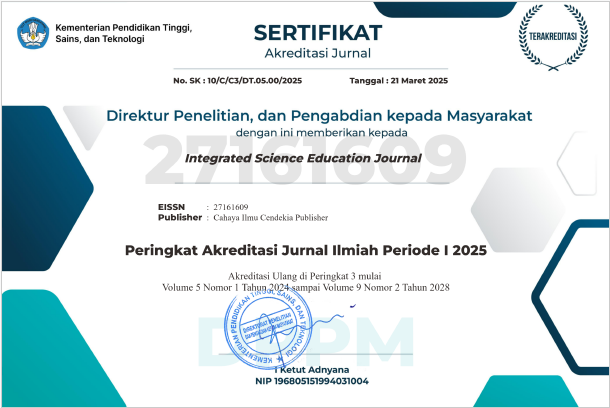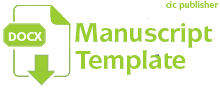Effectiveness of E-Assessment in Science Learning: Improving the Quality and Efficiency of Assessment in the Digital Era
Abstract
Purpose of the study: The aim of this research is to provide an overview of how effective the use of e-assessment is in science learning.
Methodology: This research is qualitative research with a literature review research method. The data in this research is secondary data where data is obtained from search results for documents related to the research topic. The sample from this research in the form of articles was selected based on several criteria, including publications in journals ranging from 2017-2022. After articles that match the topic and the basis of the data are collected, the researcher then carries out a review using several criteria explained in the descriptive statistics table.
Main Findings: Based on the results of a review of several relevant articles, it was found that the use of e-assessment will greatly simplify the assessment process and is useful for quickly providing results for science assessment. So the application of e-assessment for assessing student science is very necessary to be implemented in schools.
Novelty/Originality of this study: The novelty lies in its focus on the comprehensive application of e-assessment in evaluating cognitive, affective, and psychomotor aspects of science learning. The results of this research can be a basis for policy makers in developing and implementing e-assessment systems in schools. With evidence that e-assessment can speed up the assessment process and improve learning outcomes, policies that support the digitalization of assessments will be more easily accepted.
References
I. G. S. Y. Yasa, N. Dantes, and I. W. Suastra, “Pengaruh Model Pembelajaran Kooperatif Tipe Jigsaw Dan Asesmen Autentik Terhadap Hasil Belajar Ipa,” J. Lesson Learn. Stud., vol. 2, no. 3, pp. 404–413, 2019.
D. Sakinah, I. Putri, and B. T. Turaqulov, “Harmonizing Tradition , Science , and STEM Learning : Empowering Students ’ Creative Minds with Sound Waves and Local Wisdom,” vol. 3, no. 4, pp. 90–98, 2022, doi: 10.37251/sjpe.v3i4.916.
P. E. Trisnawati, N. K. Suarni, and D. P. Parmiti, “Pengaruh Model Pembelajaran Kooperatif Tipe Make a Match Berbasis Penilaian Kinerja Terhadap Prestasi Belajar Ipa,” J. Ilm. Pendidik. Profesi Guru, vol. 2, no. 1, pp. 101–109, 2019, doi: 10.23887/jippg.v2i1.18558.
N. Juharti and L. Kartika, “Comparison of Student Learning Outcomes in Class VIII SMP Negeri 2 Muaro Jambi,” Integr. Sci. Educ. J., vol. 2, no. 1, pp. 13–19, 2021, doi: 10.37251/isej.v2i1.127.
R. O. Sandra, Maison, and D. A. Kurniawan, “Pengembangan Instrument Miskonsepsi Menggunakan Dreamweaver Berbasis Web Pada Materi Tekanan Berformat Five-Tier,” J. Fis. Fis. Sains dan Apl., vol. 7, no. 1, 2022.
A. Akbar, “Correlation Study of Student Learning Motivation in Civics Subjects in High School,” J. Soc. Knowl. Educ., vol. 4, no. 2, 2023, doi: 10.37251/jske.v4i2.428.
M. Maison et al., “Comparison of student attitudes towards natural sciences,” Int. J. Eval. Res. Educ., vol. 9, no. 1, pp. 54–61, 2020, doi: 10.11591/ijere.v9i1.20394.
L. Hasibuan and A. Nugraha, “Development of Scientific and Constructivism-Based Handouts on Social Arithmetic Materials,” Indones. J. Educ. Res., vol. 4, no. 2, pp. 28–31, 2023, doi: 10.37251/ijoer.v4i2.578.
M. Iqbal and R. O. Sandra, “Analisis Sikap Mandiri Siswa SMAN 2 Kota Jambi,” J. Eval. Educ., vol. 3, no. 3, pp. 77–81, 2022, doi: 10.37251/jee.v3i3.238.
B. Retni S, K. Dwi Agus, T. Elza, and P. Rahmat, “Evaluation of the Results of Attitudes and Self-Efficacy of Middle School Students in Science Subjects,” J. Educ. Res. Eval., vol. 5, no. 4, p. 525, 2021, doi: 10.23887/jere.v5i4.36409.
C. Hidayati, E. W. P. Thet, and P. Nouanthong, “Evaluation: Media Booklet About Education on Prevention of Flour Albus for Teenage Girl,” J. Eval. Educ., vol. 5, no. 2, pp. 50–60, 2024, doi: 10.37251/jee.v5i2.928.
E. N. Setiyani, Z. Hazmi, Z. Baharin, and S. N. Jesse, “Development of POE-Based Student Worksheets ( Predict , Observe , And Explain ) for Students ’ Mathematical Representation Abilities,” J. Educ. Technol. Learn. Creat., vol. 1, no. 2, pp. 78–87, 2023, doi: 10.37251/jetlc.v1i2.792.
A. R. Wulan, A. Isnaeni, and R. Solihat, “Penggunaan Asesmen Elektronik Berbasis Edmodo Sebagai Assessment for Learning Keterampilan Abad 21,” Indones. J. Educ. Assesment, vol. 1, no. 2, p. 1, 2019, doi: 10.26499/ijea.v1i2.7.
A. B. Rifqi, “Pengaruh Implementasi Asesmen Projek Terhadap Karakter Dan Literasi Sains Siswa Kelas Iv Sd Gugus 2 Kecamatan Buleleng,” J. Pendidik. Dasar Flobamorata, vol. 2, no. 1, pp. 96–102, 2021, doi: 10.51494/jpdf.v2i1.412.
D. R. Retnani, R. Royani, C. Beccles, and A. Afras, “Improving Science Learning Outcomes on Light and Optical Instruments Through Visual Methods in Junior High Schools,” Schrödinger J. Phys. Educ., vol. 5, no. 1, pp. 32–38, 2024, doi: 10.37251/sjpe.v5i1.883.
A. Asrial, S. Syahrial, D. A. Kurniawan, R. Perdana, and R. O. Sandra, “E-Assessment: Character of Students in Elementary School,” Int. J. Interact. Mob. Technol., vol. 17, no. 05, pp. 117–142, 2023, doi: 10.3991/ijim.v17i05.34205.
J. Marzal, E. Saputra, T. Suratno, and E. Elisa, “The use of ADDIE model to re-create academic information systems to improve user satisfaction The use of ADDIE model to re-create academic information systems to improve user satisfaction,” J. Phys. Conf. Ser., vol. 1567, no. 032033, 2020, doi: 10.1088/1742-6596/1567/3/032033.
Asrial et al., “Digital E-Assessment Technology in Assessing Students’ Tolerance Character,” J. Ilm. Sekol. Dasar, vol. 6, no. 4, pp. 558–567, 2022, doi: 10.23887/jisd.v6i4.47302.
K. A. Mudanta, I. G. Astawan, and I. N. L. Jayanta, “Instrumen Penilaian Motivasi Belajar dan Hasil Belajar IPA Siswa Kelas V Sekolah Dasar,” Mimb. Ilmu, vol. 25, no. 2, p. 101, 2020, doi: 10.23887/mi.v25i2.26611.
A. N. Nugroho and G. S. Airlanda, “Pengembangan Instrumen Penilaian Keterampilan Berpikir Kritis Pembelajaran IPA Kelas 4 SD,” J. Ilm. Pendidik. Profesi Guru, vol. 3, no. 3, p. 400, 2020, doi: 10.23887/jippg.v3i3.29712.
K. Trimawati, T. Kirana, and R. Raharjo, “Pengembangan Instrumen Penilaian Ipa Terpadu Dalam Pembelajaran Model Project Based Learning (PjBL) Untuk Meningkatkan Kemampuan Berpikir Kritis Dan Kreatif Siswa SMP,” Quantum J. Inov. Pendidik. Sains, vol. 11, no. 1, p. 36, 2020, doi: 10.20527/quantum.v11i1.7606.
M. M. Asad, R. B. Khan Soomro, A. Shamsy, and P. Churi, “Students’ Satisfaction towards E-Assessment for Academic Achievement in ESL at Public Schools and Colleges,” Educ. Res. Int., vol. 2021, 2021, doi: 10.1155/2021/4576750.
M. Maison, D. Darmaji, A. Astalini, D. A. Kurniawan, Sumaryanti, and R. Perdana, “Supporting assessment in education: E-assessment interest in physics,” Univers. J. Educ. Res., vol. 8, no. 1, pp. 89–97, 2020, doi: 10.13189/ujer.2020.080110.
C. K. Y. Chan and W. Hu, “Students’ voices on generative AI: perceptions, benefits, and challenges in higher education,” Int. J. Educ. Technol. High. Educ., vol. 20, no. 1, 2023, doi: 10.1186/s41239-023-00411-8.
B. Pratiwi, I. Budiharto, and S. Fauzan, “Hubungan Kecerdasan Emosional dengan Kenakalan Remaja pada Remaja Madya: Literature Review,” Tanjungpura J. Nurs. Pract. Educ., vol. 2, no. 2, 2020, doi: 10.26418/tjnpe.v2i2.46145.
W. Mengist, T. Soromessa, and G. Legese, “Method for conducting systematic literature review and meta-analysis for environmental science research,” MethodsX, vol. 7, p. 100777, 2020, doi: 10.1016/j.mex.2019.100777.
A. Laksono and A. Widiyatmoko*, “Development of Science Digital Scrapbook as Authentic Assessment to Measure Learning Outcome of Junior High School Students,” J. Pendidik. Sains Indones., vol. 10, no. 3, pp. 451–467, 2022, doi: 10.24815/jpsi.v10i3.24100.
I. Nurhidayah and Ardi, “Instrumen E-Assessment Berbasis Quizizz tentang Materi Sistem Koordinasi untuk Kelas XI SMA/MA,” J. Ilm. Pendidik. Profesi Guru, vol. 5, no. 1, pp. 67–76, 2022, doi: 10.23887/jippg.v5i1.44006.
I. D. Pursitasari, A. Permanasari, and D. Jaenudin, “Pelatihan Penyusunan E-Asesmen Literasi Sains Berbasis AKM Bagi Guru IPA SMP di Kabupaten Bogor,” J. Pemberdaya. Masy., vol. 1, no. 1, pp. 26–33, 2022, doi: 10.46843/jmp.v1i1.265.
I. W. Widiana, “Dampak Penggunaan E-learning Berbasis Asesmen Proyek Terhadap Kemandirian Belajar dan Hasil Belajar Siswa Selama Pandemi Covid-19,” J. Penelit. dan Pengemb. Pendidik., vol. 6, no. 2, pp. 162–172, 2022, doi: 10.23887/jppp.v6i2.48850.
A. A. Dewi, “Pengembangan Instrumen E-Quiz pada Pembelajaran Daring Materi Ejosistem Kelas VII SMP,” J. Pendidik. Sains dan Mat., vol. 10, no. 2, pp. 199–212, 2022.
H. Sahidu, Gunawan, and L. Herayanti, “Persepsi Calon Guru Terhadap Model E-Assessment Dalam Pembelajaran Fisika,” J. Pendidik. Fis. dan Teknol., vol. 5, no. 1, pp. 58–66, 2019.
A. Astalini, D. Darmaji, D. A. Kurniawan, L. Anggraini, and R. Perdana, “E-Assessment on Student’s Self-Concept for Physics Learning,” J. Ilmu Pendidik., vol. 25, no. 2, p. 73, 2020, doi: 10.17977/um048v25i2p73-81.
S. A. P. Syaninditha and P. E. Setiawan, “Pengaruh Persepsi Kegunaan, Persepsi Kemudahan, Faktor Sosial, Dan Kondisi Yang Memfasilitasi Terhadap Minat Penggunaan E-Filing,” E-Jurnal Akunt., vol. 21, no. 1, pp. 86–115, 2017.
C. Ozan, “The effect of authentic assessment on academic achievement and attitude towards educational measurement and opinions of prospective teachers,” Int. J. Eval. Res. Educ., vol. 8, no. 2, pp. 299–312, 2019, doi: 10.11591/ijere.v8i2.18564.
A. K. Bansah and D. Darko Agyei, “Perceived convenience, usefulness, effectiveness and user acceptance of information technology: evaluating students’ experiences of a Learning Management System,” Technol. Pedagog. Educ., vol. 31, no. 4, pp. 431–449, 2022, doi: 10.1080/1475939X.2022.2027267.
M. Rojas-Osorio and A. Alvarez-Risco, “Intention to use smartphones among Peruvian university students,” Int. J. Interact. Mob. Technol., vol. 13, no. 3, pp. 40–52, 2019, doi: 10.3991/ijim.v13i03.9356.
F. R. Winda, W. Kurniawan, and Darmaji, “Analisis Respon Pengguna Terhadap Penerapan Web-based Assessment pada Praktikum Fisika Dasar,” EDUMASPUL J. Pendidik., vol. 5, no. 1, pp. 208–215, 2021, doi: 10.33487/edumaspul.v5i1.1140.
T. H. Wang, “Developing a web-based assessment system for evaluating examinee’s understanding of the procedure of scientific experiments,” Eurasia J. Math. Sci. Technol. Educ., vol. 14, no. 5, pp. 1791–1801, 2018, doi: 10.29333/ejmste/85170.
A. Wijayanti and M. A. Khairul Basyar, “Pengembangan E-portofolio Tematik-Terpadu Berbasis Web Blog untuk Menanamkan Karakter Kritis dan Kreatif melalui Pembelajaran IPA,” Phenom. J. Pendidik. MIPA, vol. 7, no. 1, pp. 30–39, 2017, doi: 10.21580/phen.2017.7.1.1499.
Peprizal and N. Syah, “Pengembangan Media Pembelajaran Berbasis Web Pada Mata Pelajaran Instalasi Penerangan Listrik,” J. Ilm. Pendidik. dan Pembelajaran, vol. 4, no. 3, p. 455, 2020, doi: 10.23887/jipp.v4i3.28217.
Copyright (c) 2024 Rexford Baah, Oleksandr Konovalov, Sangay Tenzin

This work is licensed under a Creative Commons Attribution 4.0 International License.
Authors who publish with this journal agree to the following terms:
- Authors retain copyright and acknowledge that the Integrated Science Education Journal is the first publisher licensed under a Creative Commons Attribution 4.0 International License.
- Authors are able to enter into separate, additional contractual arrangements for the non-exclusive distribution of the journal's published version of the work (e.g., post it to an institutional repository or publish it in a book), with an acknowledgment of its initial publication in this journal.
- Authors are permitted and encouraged to post their work online (e.g., in institutional repositories or on their website) prior to and during the submission process, as it can lead to productive exchanges and earlier and greater citation of published work.







.png)
.png)






